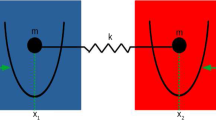Summary
We examine a light-driven dissipative engine, which must necessarily operate far from equilibrium and at a nonzero rate to be capable of providing power and work. The engine’s working fluid consists of a buffer gas and the reacting system 2SO3F⇄S2O6F2. We model the concentrations of the reacting system as functions of both temperature and pressure. Piston trajectories maximizing work output and minimizing entropy production are determined for such an engine with the rate-dependent loss mechanisms of friction and heat conduction.
Riassunto
Si esamina un motore dissipativo attivato dalla luce che deve necessariamente funzionare lontano dall’equilibrio e a una velocità diversa da zero per essere in grado di fornire potenza e lavoro. Il fluido di lavoro del motore consiste di un gas tampone e di un sistema reagente 2SO3F⇄S2O6F2. Si modellano le concentrazioni del sistema reagente in funzione sia della temperatura che della pressione. Le traiettorie del pistone che massimizzano l’uscita di lavoro e minimizzano la produzione di entropia sono determinate per un tale motore con i meccanismi di perdita dipendenti dalla velocità di attrito e conduzione di calore.
Резюме
Мы исследелуем диссипативный двигатель, приводимый в действие светом, который безусловно должен действовать далеко от равновесия и при ненулевой скорости, чтобы обеспечить производство знергии и работы. Рабочее тело двигателя представляет буфферный газ и реагирующую систему 2SO3F⇄S2O6F2. Мы моделируем концентрации реагирующей системы в зависимости от температуры и давления. Для такого двигателя определяются траектории поршня, обеспечивающие максимум работы и минимум образования энтропии, с учетом зависящих от скорости механизмов потерь на трение и теплопроводность.
Similar content being viewed by others
References
M. Mozurkewich andR. S. Berry:J. Appl. Phys.,54, 3651 (1983).
S. J. Watowich, K. H. Hoffmann andR. S. Berry:J. Appl. Phys.,58, 2893 (1985).
E. C. Zimmermann andJ. Ross:J. Chem. Phys.,80, 720 (1984).
E. C. Zimmermann, M. Schell andJ. Ross:J. Chem. Phys.,81, 1327 (1984).
A. Nitzan andJ. Ross:J. Chem. Phys.,59, 241 (1973).
C. F. Taylor:The Internal Combustion Engine in Theory and Practice, Vol.1 (MIT, Cambridge, Mass. 1966), p. 312.
S. Watowich, J. Krause andR. S. Berry: inApplications of Computer Algebra, edited byR. Pavelle (Kluwer Academic Publishers, Hingham, Mass., 1985).
F. B. Dudley andG. H. Cady:J. Am. Chem. Soc.,83, 3375 (1963).
A. E. Bryson andY. C. Ho:Applied Optimal Control (Wiley, New York, N.Y., 1975);P. Naslin:Essentials of Optimal Control (Boston Technical Publishers, Inc., Cambridge, Mass., 1969).
R. L. Crane, K. E. Hillstrom andM. Minkoff:Solution of the General Nonlinear Programming Problem with the Subroutine VMCON (ANL-80-64, Argonne National Laboratory, Argonne, Ill. 60439).
Author information
Authors and Affiliations
Additional information
Traduzione a cura della Redazione.
Переведено редакцией.
Rights and permissions
About this article
Cite this article
Watowich, S.J., Hoffmann, K.H. & Berry, R.S. Optimal paths for a bimolecular, light-driven engine. Nuov Cim B 104, 131–147 (1989). https://doi.org/10.1007/BF02906311
Received:
Published:
Issue Date:
DOI: https://doi.org/10.1007/BF02906311




